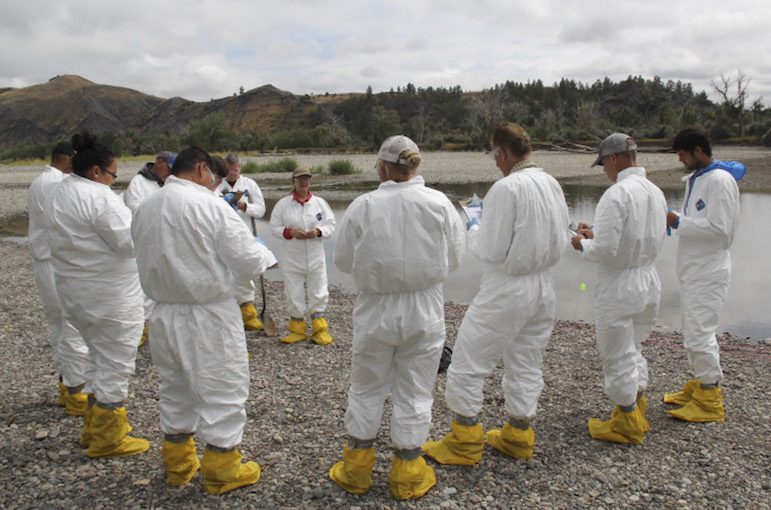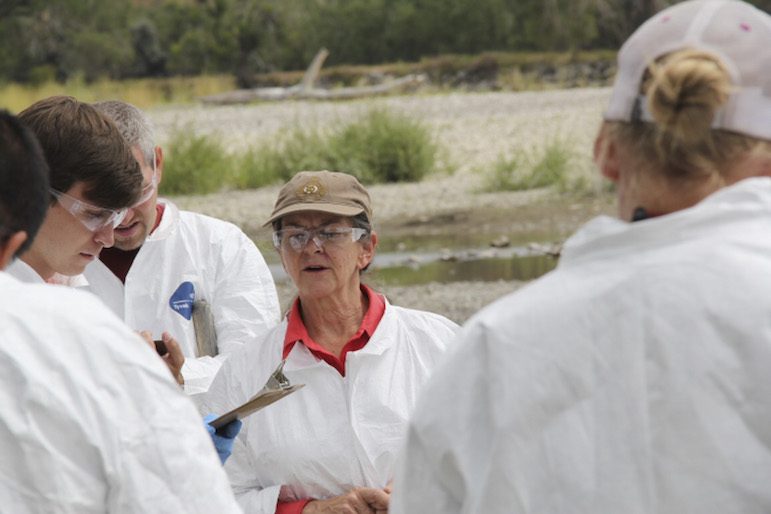A couple of visitors to Riverfront Park paused on the trail overlooking the Yellowstone River near South Bridge Thursday afternoon, looks of confusion on their faces.
Fortunately, Al Nash was nearby and he explained that the sight of 11 people in haz-mat gear was nothing to worry about.
“They were kind of wondering if they should be here,” said Nash, chief of communications for the regional office of the Bureau of Land Management.
One of the people in Tyvek suits and yellow booties was an instructor and the other 10 were federal employees, who were at Riverfront as part of training on how to respond to inland oil spills.
The park visitors could be forgiven for finding the sight alarming, given two major oil spills on the Yellowstone River in the past five years—one near Laurel in 2011 and one near Glendive in 2015.
Nash said it was partly those two spills that prompted the Department of Interior to offer training for workers from several Interior agencies to be first responders on oil spills.
The department’s Inland Oil Spill Preparedness Project was presented by instructors from a private company, Research Planning Inc., under the auspices of the U.S. Fish and Wildlife’s National Conservation and Training Center in West Virginia.
Nash said the 24 federal employees came from regional offices of the BLM, Bureau of Reclamation, Bureau of Indian Affairs, Fish and Wildlife Service and the National Park Service.Most of the weeklong training session has been confined to classrooms at the BLM regional headquarters on Southgate Drive, but on Thursday, in a couple of groups, the trainees went to the Yellowstone River for hands-on instruction.
Jacqueline Michel, one of the Research Planning Inc. instructors, said the employees were learning “shoreline cleanup assessment techniques.” As first responders, they will serve on SCAT teams—which Michel acknowledged sounded like an entirely different scientific project.
Their job will be to quickly evaluate conditions in the area of an oil spill—the extent and saturation level of the spill, the nature of the habitat, weather conditions and so on—and then help coordinate a response to the spill while cooperating with other federal agencies, Indian tribes and state agencies.

Ed Kemmick/Last Best News
Little surveying flags were used to mark the extent of a mock oil spill at Riverfront Park.
Mike Hodgkinson was there in his capacity as chief of maintenance for the Dinosaur National Monument on the Colorado-Utah state line. The NPS employee said part of his job is to develop an oil-spill-response plan for the park itself, and how to be part of a team that could respond to spills elsewhere.
“I also wanted to see what results from having a spill,” he said. The most surprising thing he’s learned this week is “what it takes to clean up an oil spill,” in terms of people and resources.
Nash said the training was realistic—he guessed few of the participants had ever donned haz-mat gear before—and useful because of where the field training was offered.
“It’s a scenario they can relate to because they’re from here,” he said.
Referring to the river training, Nash said, “we can certainly see how it could be applicable close to home,” but the training could be used to respond to oil spills anywhere in the country.







